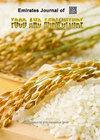Evaluation of wheat (Triticum aestivum L.) lines for drought tolerance in Kyrgyzstan
IF 0.7
4区 农林科学
Q3 AGRONOMY
引用次数: 0
Abstract
The study was carried out to explore drought stress indices in F4 hybrid generations of Triticum aestivum L. to select drought stress tolerant lines for rainfed areas of Kyrgyzstan. Wheat is the main food crop in Kyrgyzstan. There are about 0.3 million ha allotted for wheat, more than half of these sown areas (0.2 million ha) are in rainfed farming zones, where the amount of precipitation rarely exceeds 300-400 mm per year. The study was conducted in 2019 at the experimental field of Agricultural Faculty of Kyrgyz-Turkish Manas University. Eighteen hybrid lines of spring wheat and two released varieties (standard) were evaluated under irrigated and non-irrigated conditions. The results of the study show that the mean grain yield of evaluated lines under stress condition as compared to non-stressed condition was decreased by 51.72%. The analysis of correlation coefficient indicated that the productivity of lines under both conditions highly depends from their stress tolerance indexes (STI) (0.769 to 0.928). Tolerance index (TOL) and stress susceptibility index (STI) were negatively correlated (-0.411 to -0.813) with yield of genotypes under stress condition (YS). The correlation between yield stability index (YSI) and yield of genotypes under stress condition (YS) was strongly and highly positive (1.000). Based on provided analysis, Line-1, Line-3, Line-5, Line-12, Line-13, Line-14 and Line-15 were selected as potential genotypes to cultivate in drought areas of Kyrgyzstan and can be used as drought tolerance genetic resources in crop improvement programs. Keywords: Correlation; Drought tolerance; Hybrid lines; Stress tolerance indices; Triticum aestivum L.吉尔吉斯斯坦小麦(Triticum aestivum L.)抗旱性评价
本研究旨在探讨小麦F4代杂交后代的干旱胁迫指标,以筛选吉尔吉斯斯坦干旱区的耐旱品系。小麦是吉尔吉斯斯坦的主要粮食作物。分配给小麦的面积约为30万公顷,其中一半以上的播种面积(20万公顷)位于雨养农业区,那里的年降水量很少超过300-400毫米。这项研究于2019年在吉尔吉斯斯坦-土耳其马纳斯大学农业学院的试验场进行。在灌溉和非灌溉条件下,对18个春小麦杂交系和2个发布品种(标准)进行了评价。研究结果表明,与非胁迫条件相比,胁迫条件下评价品系的平均籽粒产量下降了51.72%。相关系数分析表明,两种条件下品系的生产力在很大程度上取决于它们的抗逆性指数(STI)(0.769~0.928)与胁迫条件下各基因型的产量呈负相关(-0.411~-0.813)。产量稳定性指数(YSI)与各基因型在胁迫条件下的产量呈强正相关(1.000),14和15系被选为吉尔吉斯斯坦干旱地区栽培的潜在基因型,可作为作物改良的耐旱遗传资源。关键词:相关性;耐旱性;混合系;应力耐受指数;小麦。
本文章由计算机程序翻译,如有差异,请以英文原文为准。
求助全文
约1分钟内获得全文
求助全文
来源期刊

Emirates Journal of Food and Agriculture
AGRONOMYFOOD SCIENCE & TECHNOLOGY&nb-FOOD SCIENCE & TECHNOLOGY
CiteScore
1.80
自引率
0.00%
发文量
18
期刊介绍:
The "Emirates Journal of Food and Agriculture [EJFA]" is a unique, peer-reviewed Journal of Food and Agriculture publishing basic and applied research articles in the field of agricultural and food sciences by the College of Food and Agriculture, United Arab Emirates University, United Arab Emirates.
 求助内容:
求助内容: 应助结果提醒方式:
应助结果提醒方式:


